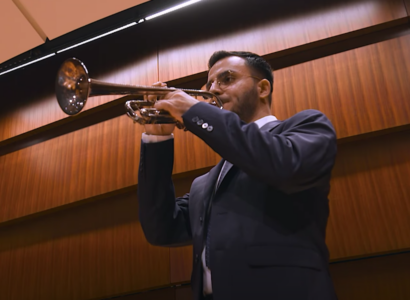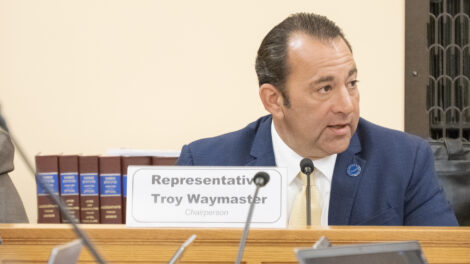
KU still trying to figure out how it will pay student-athletes, but chancellor says cutting sports programs is not part of the plan
New rules likely will mean about 50 fewer student-athletes at KU

The University of Kansas doesn’t have plans to eliminate any of its money-losing Olympic sports despite great uncertainty about whether the athletic department can afford to pay student-athletes in the future, KU’s chancellor said.
The future of those programs — which range from big ones like track and field to smaller ones like golf and tennis — has been the focus of speculation across the country as a federal court in April is expected to finalize a lawsuit settlement that will allow universities to start paying student-athletes. Initially, programs like KU could spend slightly more than $20 million a year to pay student-athletes, over and above the scholarships they often receive. That amount would grow through the years as athletic department revenues grow.
But KU is like many other athletic department programs across the country: It doesn’t know where it would find $20 million a year in its current budget to pay student-athletes. But it also knows that if it doesn’t find the money — the lawsuit settlement will allow but not require schools to pay student-athletes — that remaining competitive in the top tier of college athletics will be very difficult.
Chancellor Douglas Girod has been blunt in saying he doesn’t know how KU is going to solve that problem. He knows it is not a satisfying answer — but it does have the benefit of being an honest one.
“If anyone tells you they have it figured out, they are lying,” Girod said during a brief interview recently. “I have talked to dozens of chancellors and presidents, and they are all scratching their heads.”
At this point, Girod is more comfortable in saying what KU isn’t considering: Cutting sports.
“To be honest, you don’t save a whole bunch of money doing that. It is not really a priority for us,” Girod said of using sports cuts to solve the pending budget crunch.
There may be another reason KU isn’t considering such cuts: The university would face a big loss in status if it cut any sport. Currently, NCAA rules require any university that wants to compete in the highest level of Division I athletics to field 16 sports programs. That is exactly how many KU has currently.
Student-athletes and coaches of KU Olympic sports may still have reason to be wary, though. While cutting entire programs may not be the question floating through the halls of athletic departments, the numbers suggest another question will soon emerge:
Are we in it to win it?
Roster changes
An analysis of the pending legal settlement shows KU will have some decisions to make on whether to invest new money in the Olympic sports. If it doesn’t, those sports may have a hard time competing in the future.
The reason is because major roster changes will come to college athletics as part of the legal settlement. No longer will individual sports have limits on the number of scholarships they can offer. Instead, they will have limits on how large their overall rosters can be.
The change is expected to create two impacts. The most certain one is that some students will see their college athletic careers end because there will no longer be a roster spot for them. Walk-on student-athletes — the term for student-athletes who don’t receive a scholarship — are the most likely to lose spots.
An analysis by the Journal-World found that, compared to 2023 totals, there will be 49 fewer spots for student-athletes across KU’s 16 sports when the new rules are expected to take effect in 2025-2026. That would be an almost 10% reduction in student-athletes at KU.
But the other impact might be the one that creates havoc in the competitive landscape. Schools now will be allowed to give every student-athlete who is on a roster a scholarship. That is not how the system works today.
Take, for instance, baseball. In 2023, there were 40 players on the roster. However, NCAA rules limit the number of scholarships that can be offered to 11.7, meaning most players are receiving partial scholarships, and all those partial scholarships add up to the equivalent of just less than 12 full-ride scholarships.
In the 2025-2026 school year, the size of the baseball team will shrink to 34 players. Six students will no longer have the chance to be a Jayhawk baseball player. However, all 34 remaining players can receive a full scholarship — if the university invests the money to make it happen.
2023 Profit and Loss by Sport
• Baseball: $4.0 million loss
• Women’s basketball: $4.7 million loss
• Men’s golf: $1.2 million loss
• Women’s golf: $1.0 million loss
• Rowing: $2.2 million loss
• Soccer: $2.4 million loss
• Softball: $2.2 million loss
• Swimming & diving: $1.7 million loss
• Tennis: $1.6 million loss
• Women’s track & field/cross-country: $2.8 million loss
• Men’s track & field/cross-country: $2.8 million loss
• Volleyball: $1.9 million loss
• Men’s basketball: $3 million profit
• Football: $17 million profit
How much money would that take? I haven’t seen any official numbers from KU, and to be clear, Girod and I did not dive into any of these scholarship issues during our interview. Instead, I looked at the 2023 NCAA financial filings for KU and found that the athletic department provided $15.2 million in student aid to 432 athletes. That’s an average of $35,185 per student-athlete.
If you simply use that average, it would cost about $785,000 per year to fund the approximately 22 new scholarship positions that would be available on the baseball team. That would be about a 20% increase in the total operating expenses of the baseball program. The baseball program in 2023 operated at an approximately $4 million loss.
The story is much the same for every sport other than football and men’s basketball. In total, KU, using the average above, is looking at $6.7 million in additional scholarship money that is needed to bring all its teams — minus football and men’s basketball — to the full scholarship levels. Those programs posted a $28.4 million operating loss in 2023. Only football and men’s basketball in 2023 posted an operating profit. The two sports combined had operating revenues that were $20 million over operating expenses, according to the NCAA filings.
If this were only a money question, the answers would be pretty easy. But college athletics still have elements of education, opportunity and equity. At the end of the day, though, the concept of competition is paramount.
That comes back to the growing question in college athletics: Are you in it to win it?
Take baseball as the example again. KU may decide not to invest the more than $700,000 a year in additional scholarship money to field a team that is fully stocked with scholarship players. But certainly some schools will. That discrepancy is likely to have competitive implications.
That’s the polite way to say it.
Donors to the rescue?
If you have been doing the math as we go, you realize we have a problem. The group of sports that are money-losers lost $28 million, while the two sports that are money-makers made $20 million. We are $8 million short.
Donors, along with other revenue sources, make up the difference. The $8 million gap is deceiving, though. KU had about $52 million in other expenses in 2023 that weren’t tied to any one team. That’s everything from administrative salaries to debt payments to a host of other expenses required to run a $100 million-plus enterprise.
Changing Rosters
Here’s a look at changing roster sizes for the 2025-2026 season compared to 2023 numbers:
• Baseball: down 6
• Men’s cross country: no change
• Women’s cross country: down 2
• Football: down 18
• Men’s basketball: down 2
• Women’s basketball: no change
• Men’s golf: down 2
• Women’s golf: down 3
• Rowing: down 4
• Soccer: down 3
• Softball: up 2
• Swimming: down 2
• Tennis: down 1
• Men’s track: down 5
• Women’s track: down 2
• Volleyball: down 1
Fortunately for KU, it had about $64 million in revenues that weren’t tied to any one team, with a little less than half that amount coming from donors. Add it all up, and Kansas Athletics ended 2023 with revenues being about $4 million greater than expenses. In the world of college athletics, that is not a given. There are many schools that end the year with a deficit and have to seek money from general university coffers to cover the shortfall. Girod has said multiple times that KU must avoid that situation at nearly all costs.
But that brings us to the 2025-2026 school year. If the lawsuit settlement is approved, KU will need to find about $20 million to pay student-athletes and another $5 million to $7 million, perhaps, to fully stock teams with scholarship players.
Maybe donors could be the answer. Maybe, but a little perspective might be helpful. Donors provided about $29 million to Kansas Athletics in 2023. That would mean donors would need to nearly double their contributions to also cover the $25 million to $27 million gap created by the lawsuit settlement. And, they might need to be prepared to do that year after year. Plus, the cost of the settlement will grow over the years. The settlement is structured such that the amount schools can pay athletes rises as the total revenue of athletic departments increases.
Additionally, there’s a question of how much more donors at KU can give. This lawsuit settlement is hitting KU at a time when it already is tapping donors in a big way for facility improvements. Donors have pledged about $250 million for renovations to the west side of David Booth Kansas Memorial Stadium. It is very likely the university will ask for additional donor dollars to complete the east side of the stadium renovations in the near future. KU is betting the new stadium will create new revenues. It will need to because KU also plans to take out at least $115 million in new debt to help pay for the west side renovations. It is unclear whether it will have to take out additional debt for the east side improvements.
Maybe donors can’t ride to the rescue. Cost-cutting might have to be part of the equation, and KU has hired one of the most renowned accounting firms in the country — Deloitte — to study athletic department finance.
Scholarship changes
While roster sizes generally are going down, the number of scholarships the university can offer on each team is generally going up.
• Baseball: up 22.3 scholarships
• Men’s cross-country: up 4.54
• Women’s cross-country: down 1
• Football: up 20
• Men’s basketball: up 2
• Women’s basketball: up 1.5
• Men’s golf: up 4.5
• Women’s golf: up 3
• Rowing: up 48.44
• Soccer: up 14.04
• Softball: up 13
• Swimming: up 16.5
• Tennis: up 2.5
• Men’s track: up 27
• Women’s track: up 27
• Volleyball: up 6
The common fan on the street may be screaming that they can save the firm the trouble — reduce coaches’ salaries. KU did pay $23.5 million in coaching salaries in 2023. That’s a lot, but it also is worth noting that every KU coach could agree to work for free, and you still wouldn’t quite cover the pending $25 million to $27 million shortfall.
The payroll category that actually is larger at KU is the money paid to athletic administrators and support staff. That figure was $28.3 million in 2023. Of course, it is not realistic to simply eliminate that category, which includes everything from the athletic director to administrative assistants.
If you cut 50% from both the coaching category and the administrative category, you would basically cover your projected shortfall. That’s not a recommendation, by the way, but rather an example of how deep the cuts would have to be if you chose to operate with blunt instruments.
That’s an operation that would require a lot of anesthesia.
Of course, you could do nothing. The pending settlement doesn’t require any university to pay student-athletes. It simply allows them to pay student-athletes, and places a cap on how much.
“You don’t have to pay anything,” Jeff DeWitt, the university’s chief financial officer, noted in a recent interview. “It is a cap, not a requirement. But how do you remain the No. 1 ranked in basketball? How do you move up the Big 12 in football?”
Another option is that maybe the Big 12 Conference comes together and creates its own, lower caps on payments and/or scholarships. That may maintain some competitive balance in the conference, but what would happen in postseason play when those Big 12 schools are competing against other schools that are operating with higher caps?
That’s an operation that may require a bunker for university presidents to hide from angry fans and donors who become frustrated at early exits from NCAA tournaments or bowl blowouts.
That seemingly brings us right back to where we began.
“Nobody knows,” DeWitt said of how KU or other athletic departments are going to deal with the pending settlement. “If you want me to give you any certainty, I can’t.”









